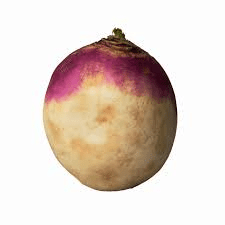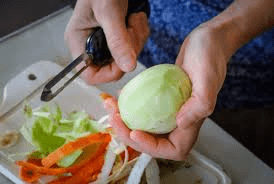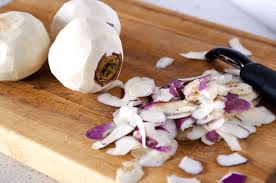The Turnip Skin of the turnip (Brassica rapa subsp. rapa) plays a vital role in the vegetable’s overall structure and functionality. This outer layer, though often overlooked, is integral to the turnip’s health, protection, and culinary use.
Turnip skin, also known as the epidermis, is the outermost layer of the turnip bulb. It is a protective barrier that shields the underlying flesh from environmental factors such as pathogens, physical damage, and moisture loss. The epidermis is composed of a single layer of cells that are often covered by a thin, waxy cuticle. This cuticle helps to reduce water loss, which is crucial for maintaining the bulb’s internal moisture and firmness.
The appearance of turnip skin can vary depending on the turnip variety. It can be white, purple, or a combination of colors, sometimes featuring a mottled pattern. The skin’s color is often a result of pigments such as anthocyanins, which can also have antioxidant properties. The skin’s texture ranges from smooth to slightly rough, depending on growing conditions and the specific variety of turnip.
Turnip skin is not just a protective layer; it also contributes to the vegetable’s nutritional profile. The skin contains a significant amount of dietary fiber, which aids in digestion and helps to maintain healthy cholesterol levels. Fiber is an essential component of a balanced diet and can contribute to overall gut health.
In addition to fiber, turnip skin contains various phytochemicals, including glucosinolates. These sulfur-containing compounds are known for their potential health benefits, including anti-inflammatory and anticancer properties. While the highest concentrations of glucosinolates are typically found in the flesh of the turnip, the skin also contributes to the overall bioactive compound content of the vegetable.
In culinary practices, turnip skin is often left on during preparation to retain the vegetable’s nutrients and flavor. The skin adds a subtle texture and can enhance the turnip’s flavor profile. For recipes that involve roasting, boiling, or stewing, keeping the skin on can contribute additional nutrients and help the turnip maintain its shape and structure.
However, before using turnips with their skin, it is essential to wash them thoroughly to remove any soil, pesticides, or contaminants. Organic turnips, which are grown without synthetic pesticides, may be preferable if the skin is to be consumed.
From an agricultural perspective, the quality of turnip skin can be influenced by growing conditions. Factors such as soil quality, watering practices, and pest management can affect the skin’s texture and appearance. Healthy turnip skin indicates good overall plant health and optimal growing conditions.
Turnip skin is a crucial component of the turnip bulb, serving both protective and nutritional roles. Its ability to shield the turnip from environmental stresses while contributing to its nutritional value makes it an important part of this vegetable. Whether enjoyed for its texture, flavor, or health benefits, the turnip skin is an integral element that enhances the overall value of the turnip in both culinary and nutritional contexts.
The Economic Importance and Uses of Turnip Skin

1. Food Ingredient: Turnip skin is often used in cooking for its added texture and flavor. Example: Roasted turnip skin as a crunchy snack.
2. Nutritional Value: Turnip skin is rich in fiber, vitamins, and antioxidants, contributing to a healthy diet.
3. Traditional Medicine: In some cultures, turnip skin is used for its potential health benefits, including aiding digestion and providing anti-inflammatory effects. Example: Turnip skin tea for digestive health.
4. Agriculture: Utilizing turnip skin reduces waste and maximizes the economic value of the turnip crop.
5. Animal Feed: Turnip skins can be used as feed for livestock, adding nutritional value to animal diets. Example: Turnip skin feed for poultry.
6. Culinary Delicacy: Turnip skins are sometimes used in gourmet dishes to add unique flavors and textures. Example: Turnip skin crisps in fine dining.
7. Soil Improvement: Composted turnip skins can enhance soil health and fertility. Example: Organic compost made from turnip skins.
8. Eco-Friendly Practices: Using turnip skins reduces food waste and supports sustainable practices.
9. Culinary Innovation: Chefs use turnip skins to create innovative dishes and flavor profiles. Example: Turnip skin-infused oil.
10. Export Potential: There is potential for turnip skin products in niche markets, such as specialty food or health products.
11. Income Diversification: Selling products made from turnip skins provides additional revenue streams for farmers.
12. Seasonal Employment: Processing turnip skins creates job opportunities in agriculture and food industries.
13. Home Gardening: Home gardeners can use turnip skins to make compost or feed, maximizing the use of their produce.
14. Edible Landscaping: Turnips, including their skins, can be part of edible landscaping, combining aesthetic appeal with practical use.
15. Organic Farming: Turnip skins can be used in organic farming practices, contributing to a sustainable cycle.
16. Agro-Tourism: Farms that highlight the use of turnip skins can attract tourists interested in sustainable farming and food waste reduction.
17. Culinary Education: Turnip skins are used in cooking schools to teach about the use of vegetable by-products.
18. Local Cuisine Promotion: Promoting turnip skins in local cuisine helps reduce food waste and supports local food systems.
Read Also: 7 Medicinal Health Benefits of Gynostemma pentaphyllum (Southern Ginseng)
The Products and By-products That Can Be Derived From Turnip Skin

1. Turnip Skin Chips: Baked or fried and seasoned for a crunchy snack. Example: Turnip skin chips as a healthy snack alternative.
2. Turnip Skin Powder: Ground into a powder for use in soups, sauces, or as a seasoning. Example: Turnip skin powder in smoothies.
3. Turnip Skin Compost: Used to enrich soil and improve garden health. Example: Compost made from turnip skins.
4. Turnip Skin Tea: Infused in hot water to make a herbal tea. Example: Turnip skin tea for its potential digestive benefits.
5. Turnip Skin Oil: Extracted for use in cooking or as a flavoring agent. Example: Turnip skin-infused oil in dressings.
6. Turnip Skin Pickles: Preserved in brine or vinegar. Example: Pickled turnip skins as a condiment.
7. Turnip Skin Flour: Ground into flour for baking or cooking. Example: Turnip skin flour in gluten-free recipes.
8. Turnip Skin Syrup: Made as a sweetener or flavoring agent. Example: Turnip skin syrup in desserts and beverages.
9. Animal Feed: Used as a supplement in animal diets. Example: Turnip skin feed for livestock.
10. Natural Dye: Produces natural dyes for fabrics and crafts. Example: Turnip skin dye for textiles.
11. Turnip Skin Paste: Blended into a paste for use in sauces and spreads. Example: Turnip skin paste in savory spreads.
12. Biofuel: Processed into biofuel. Example: Biogas production from turnip skin waste.
13. Flavoring Agents: Used to enhance the flavor of foods and beverages. Example: Turnip skin flavoring in soups and sauces.
14. Nutritional Supplements: Encapsulated as dietary supplements. Example: Turnip skin supplement capsules.
15. Antioxidant Source: Contains antioxidants used in health products. Example: Antioxidant-rich turnip skin extract.
16. Culinary Decor: Used to decorate dishes, adding visual appeal. Example: Turnip skin garnishes on salads.
17. Edible Garnishes: Used to add texture and flavor to dishes. Example: Turnip skin garnishes in gourmet cuisine.
Read Also: 7 Medicinal Health Benefits of Sandalwood (Santalum album)
Frequently Asked Questions (FAQ’s) About Turnip Skin

1. What is turnip skin?
Turnip skin is the outer layer of the turnip bulb, which is often discarded but can be used in various ways.
2. Is turnip skin edible?
Yes, turnip skin is edible and can be used in cooking or as a component in various products.
3. How do you prepare turnip skin for cooking?
Wash thoroughly, peel if desired, and use in cooking or baking as needed.
4. What does turnip skin taste like?
Turnip skin has a slightly earthy and peppery flavor, similar to the turnip itself.
5. Are there any health benefits to eating turnip skin?
Yes, turnip skin is rich in fiber, vitamins, and antioxidants, which can contribute to a healthy diet.
6. Can turnip skin be eaten raw?
Yes, but it is often cooked to enhance its flavor and texture.
7. How do you store turnip skin?
Turnip skins should be stored in the refrigerator and used within a few days. They can also be dried or processed for longer storage.
8. Are there any traditional uses for turnip skin?
Yes, in some cultures, turnip skin is used in traditional medicine for its potential health benefits.
9. Can turnip skin be used in organic farming?
Yes, turnip skin can be composted and used to enrich soil in organic farming practices.
10. What are some recipes that use turnip skin?
Turnip skin can be used in recipes such as turnip skin chips, soups, and as a flavoring agent in various dishes.
Read Also: Waste Management Startups: The Future of Sustainable Waste Management

